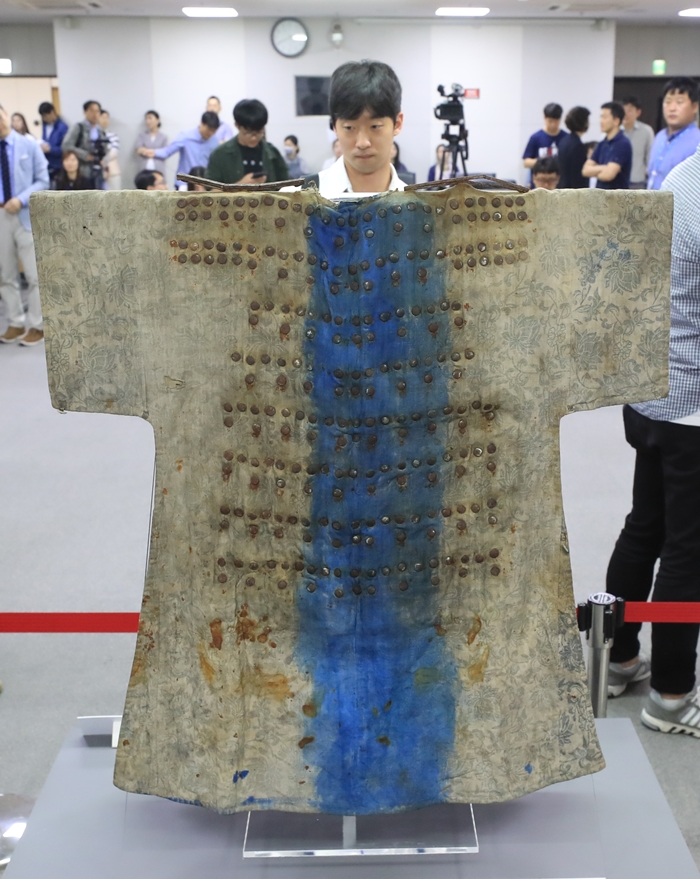A ceremony to return a set of Joseon armor to Korea from Germany takes place at the National Palace Museum of Korea on May 30. Administrator Kim Jong-Jin of the Cultural Heritage Administration and Theopil Gaus of the Archabbey of Sankt Ottilien Mission Museum attend the ceremony. (Overseas Korean Cultural Heritage Foundation)
By Min Yea-Ji and Sohn JiAe
A set of Joseon armor has been returned home from Germany after about 100 years.
The set of armor, highly acclaimed at home and abroad for its value as a cultural asset, will be made public after a process of preservation and academic research.
The Archabbey of Sankt Ottilien Mission Museum decided to return the set of armor to Korea, rather than to keep it, so as to help Korea keep alive its cultural heritage assets.
Before this set of armor, the same museum has also sent back to Korea a range of artifacts on four occasions. Those four assets include, in 2005, a late Joseon painting by Gyeomjae Jeong Seon (167601759) drawn on silk, in 2014 a Joseon botanical specimen collected by a German priest in Korea, in 2016 a Joseon document of a family registry from Iksan in Jeollanam-do Province, and earlier this year the first Korean book about Western beekeeping skills written by a German priest.
The journey home for the Korean cultural heritage items that have been lucky enough to find their way back home has not been easy.
For example, Korea was able to get back a set of royal Joseon protocols, known as the Uigwe, which was plundered by French soldiers during the 1866 Byeongin Yangyo, a French campaign against Joseon in retaliation for the execution of French missionaries. It was not completely returned, though, but arrived home in such a way that Korea had to "rent" it from France in return for importing French high-speed train technology, and Korea has to renew the contract every five years.
There was another case where Korean artifacts were removed from a Japanese center and returned to Korea. Four Koreans stole a seated gilt-bronze Amitabul statue from Japan and returned it to home. A written record found inside the statue said that the Buddhist work was originally built in 1330 at Buseoksa Temple in Seosan-si, Chungcheongnam-do Province, and the entire affair sparked controversy over whether it belonged to Korea or to Japan.
Father Theopil Gaus, head of the German museum, said in a ceremony at the National Palace Museum of Korea on May 30, that, “This set of armor has been damaged a lot due to a bad preservation process. For this, we decided to return it to Korea so the nation could keep it and do research for conservation.”
“This historical item has been returned to this beautiful country. I’m so proud that this proves the close cooperation, cultural communication and friendship between our two countries,” he said.
The National Palace Museum of Korea plans to create a replica of the armor based on the results of its research and to send it to the Archabbey of Sankt Ottilien Mission Museum.

A myeonpigap (면피갑), a set of armor worn by infantry soldiers in late Joseon, is returned to Korea after 100 years in Germany. It was unveiled on May 30 at the National Palace Museum of Korea. (Yonhap News)
jesimin@korea.kr
Most popular
- Grammy-winning producer calls Suga of BTS 'amazing artist'
- 'Universal love, family' themes fuel success of 'King of Kings': director
- Council sets minimum hourly wage in 2026 at KRW 10,320
- Songs from animated K-pop film rule Spotify daily chart in US
- Exhibition 'K-Comics World' hawks webtoons in 5 countries
